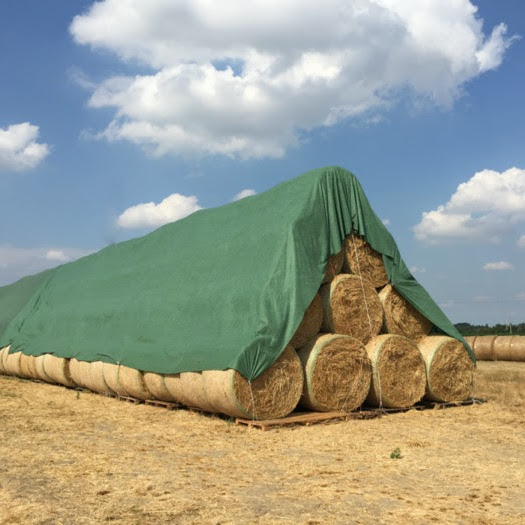In the agricultural landscape, hay tarps play a pivotal role in protecting harvested hay from the elements – rain, snow, sun, and even pests. These versatile covers ensure that hay retains its nutritional value and stays dry for livestock consumption or storage purposes. With a wide array of options available on the market, choosing the right hay tarp can be overwhelming. To simplify your decision-making process, let’s delve into the various types of hay tarps, highlighting their unique features, benefits, and suitability for different applications.

I. Polyethylene Hay Tarps
Key Features:
1. Durability:
Made from high-density polyethylene (HDPE) or low-density polyethylene (LDPE), these tarps are known for their strength and resistance to tears and punctures.
2. Waterproofing:
Fully waterproof, they effectively keep moisture out, preventing hay from mold and rot.
3. UV Protection:
Many models come with UV inhibitors, prolonging the tarp’s lifespan by preventing sunlight degradation.
4. Lightweight:
Easy to handle and transport, making them ideal for frequent moving or covering large areas.
Benefits:
Cost-effective solution for short to medium-term storage needs.
Versatile use in various weather conditions.
Quick and straightforward installation process.
II. Canvas Hay Tarps
Key Features:
1. Heavy-Duty Material:
Crafted from cotton or synthetic blends, canvas tarps provide superior durability and tear resistance.
2. Breathability:
Unlike fully waterproof tarps, canvas allows some air circulation, reducing condensation build-up under the cover.
3. Longevity:
With proper care, canvas tarps can last for years, making them a great investment for long-term storage.
4. Customization:
Available in various sizes and colors, and can often be customized to fit specific dimensions or needs.
Benefits:
Suitable for environments with high humidity, minimizing moisture damage.
Enhanced durability for rough handling or exposure to harsh weather.
Aesthetic appeal, blending seamlessly with traditional farming settings.
III. Vinyl-Coated Polyester Hay Tarps
Key Features:
1. Enhanced Strength:
Vinyl-coated polyester combines the strength of polyester fibers with the durability of vinyl, making it incredibly tough.
2. Weather Resistance:
Highly resistant to water, wind, and sun damage, ensuring long-lasting protection.
3. Flexibility:
Retains its shape and flexibility even in cold temperatures, preventing cracking or tearing.
4. Mildew Resistance:
Special coatings prevent the growth of mold and mildew, keeping hay fresh.
Benefits:
Ideal for outdoor storage in all seasons, including extreme weather conditions.
Easy to clean and maintain, maintaining a like-new appearance for longer.
Provides a balance between durability and affordability, making it a popular choice among farmers.
IV. Haystack Tarps with Reinforced Corners and Edges
Key Features:
1. Reinforced Construction:
Features double- or triple-stitched seams and extra-strong corners, ensuring the tarp stays in place even under heavy loads or windy conditions.
2. Custom Sizes:
Available in a range of sizes to fit various haystack dimensions, reducing the need for cutting or adjustment.
3. Tie-Down Options:
Includes loops, grommets, or reinforced edges for easy tie-down using ropes or stakes, providing a secure fit.
Benefits:
Ensures the stability and integrity of haystacks, preventing collapse or damage from the elements.
Minimizes waste by allowing for a precise fit, eliminating the need for extra material.
Provides peace of mind for farmers, knowing their hay is safely stored.
V. Collapsible Hay Tarps with Easy Storage
Key Features:
1. Collapsible Design:
Folds or rolls up compactly for easy storage and transportation, saving space when not in use.
2. Lightweight Material:
Typically made from lightweight but durable materials, making them manageable even by one person.
3. Quick Deployment:
Designed for quick setup and teardown, saving time and effort during hay harvesting and storage seasons.
Benefits:
Ideal for farmers who need to frequently move or store hay tarps.
Space-saving solution for small barns or sheds.
Increases efficiency during busy farming periods.
Conclusion
Choosing the right hay tarp depends on various factors, including the duration of storage, the local climate, and personal preferences. From durable polyethylene tarps to specialized haystack covers with reinforced corners, each type offers unique benefits tailored to specific needs. By considering the key features, benefits, and suitability for your specific application, you can make an informed decision that ensures your hay stays protected and ready for use when needed. Whether you’re a seasoned farmer or just starting out, investing in a high-quality hay tarp is a smart move towards maximizing your harvest’s potential.
